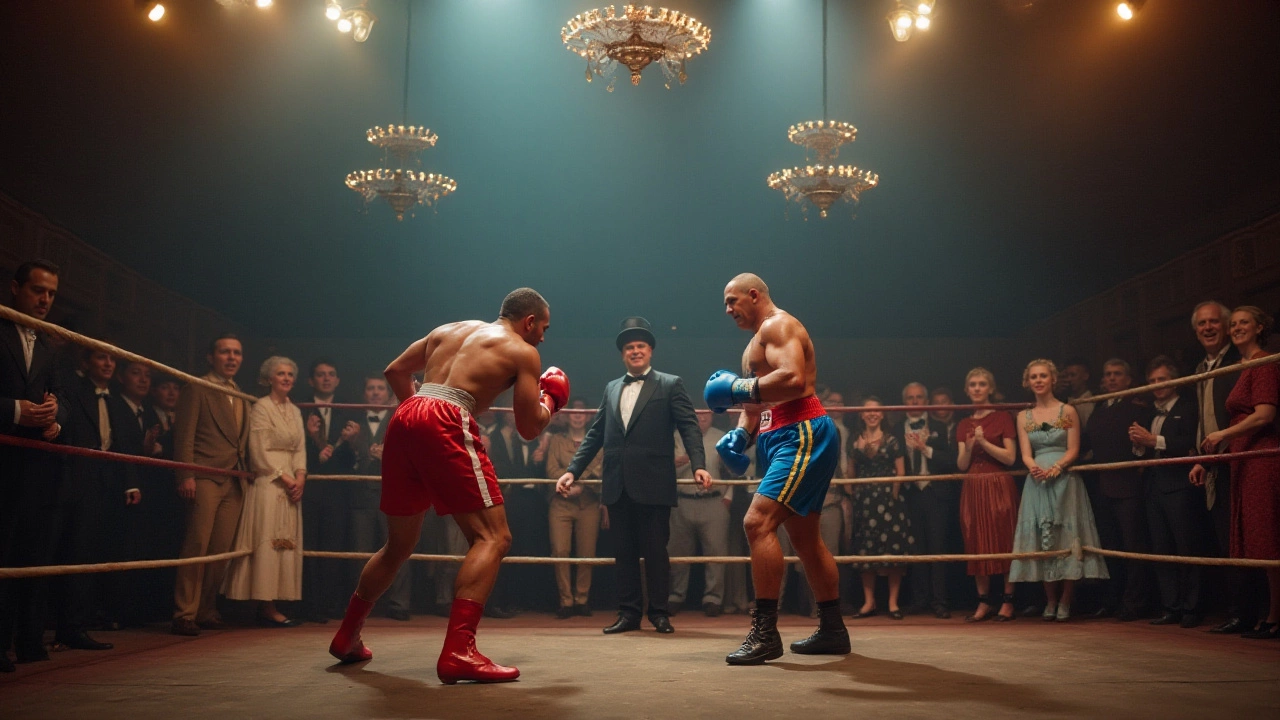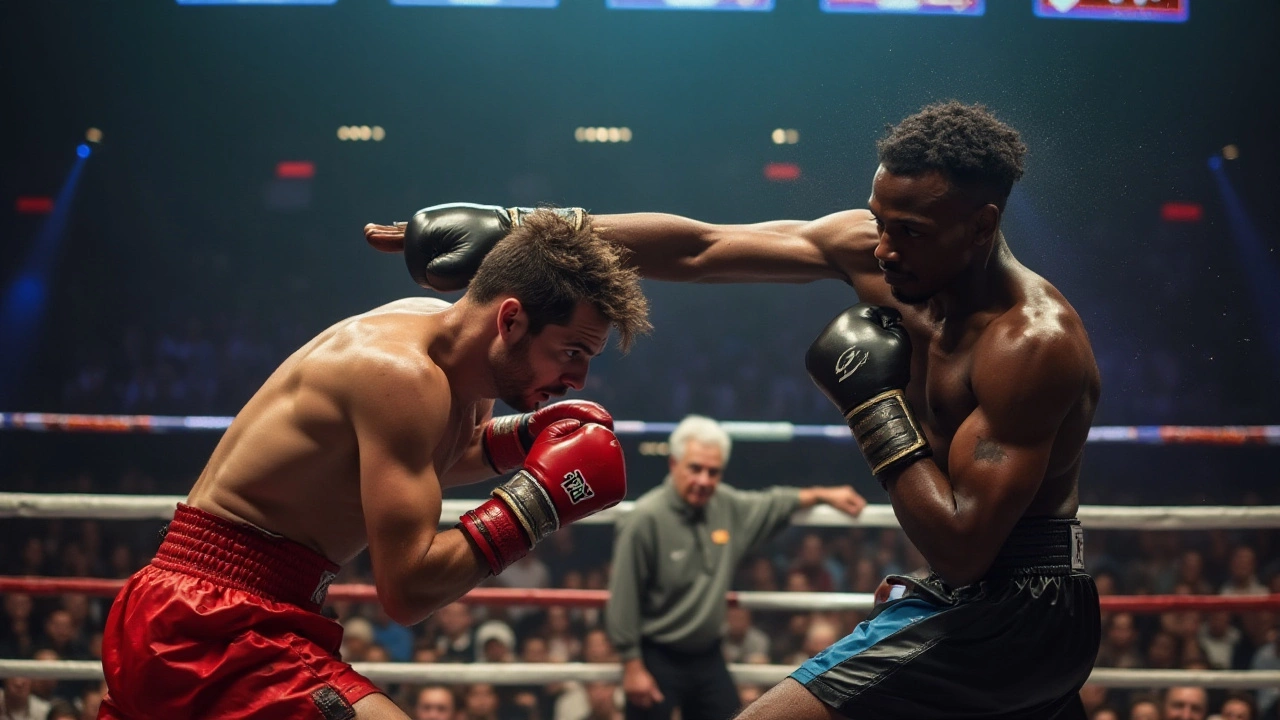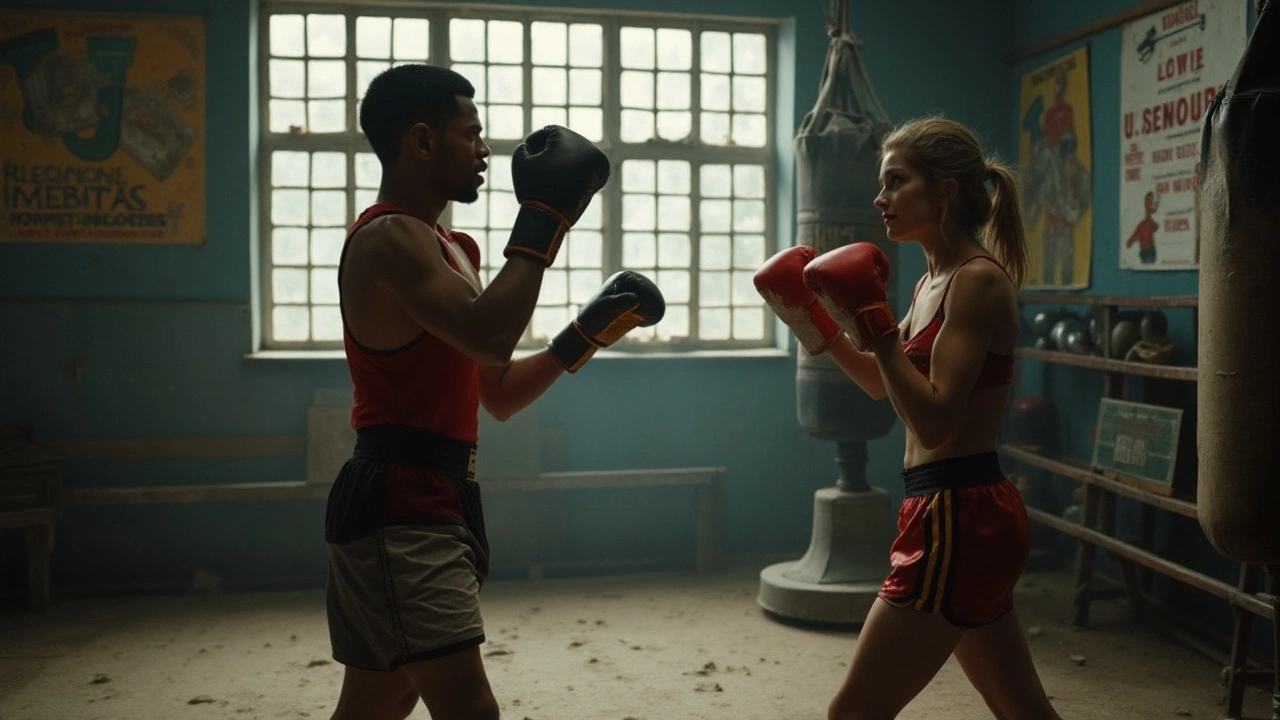Understanding Boxing Matches: A Deep Dive into the Sport

Boxing matches have long been a source of fascination, a true testament to a participant's skill, resilience, and strategy. Stepping into the squared circle isn't just about strength; it's about mind games and mastering an art.
From ancient arenas to modern stadiums, boxing has undergone incredible transformations. Understanding the core rules and nuances of this sport can help enthusiasts appreciate the layers that each bout entails. Whether you're a spectator or dreaming of stepping into the ring, grasping these essentials will enrich your boxing journey.
- History and Evolution of Boxing
- Fundamental Rules and Structure
- The Role of a Referee
- Boxing Techniques and Preparation
- Famous Fights and Legends
History and Evolution of Boxing
Boxing is one of humanity's oldest sports, drawing its origins and roots deep from the sands of ancient Mesopotamia and Egypt. The allure of boxing lies in its primal simplicity: two opponents use their fists to outlast and outsmart each other. Early depictions of boxing, dating back to around 3000 BC, show that combatants used leather strips to protect their hands, a precursor to modern gloves. Ancient Greece and Rome embraced boxing, even going so far as to include it in their original Olympic Games. In these times, the sport was often brutal, without rounds or regulated weights, and usually concluded with one fighter giving up or being unable to continue. Ethos around honor and courage were tightly interwoven with the sport's culture.
As boxing spread through the ages, the Romans added their flair by introducing the 'cestus,' a glove with metal studs for more injurious effects. However, post the fall of the Roman Empire, boxing faced decline in much of Europe, temporarily losing its luster until it found a rebirth in the bare-knuckle bouts of 17th-century Britain. This era ushered in the first attempts at formalized rules by the London Prize Ring Rules in 1743. The aim was to instill some order and avoid fatal encounters, a sentiment encapsulated in the public’s changing tastes toward more structured and less bloody displays. With industrialization, guidelines evolved significantly during the 19th century with the introduction of the Marquess of Queensberry Rules in 1867, identifying paint-points of bare-knuckle fighting and streamlining the sport into a safer, more regimented competition.
The 20th century became the golden age of boxing as it melded into popular culture. It thrived in both amateur and professional arenas, witnessing figures like Muhammad Ali and Joe Louis turn into household names, transcending sports to become global icons. This transition highlighted boxing not just as a sport but also as a stage for social change, with fighters often becoming figureheads in the struggle for civil rights and equality. Quotes from Ali ring true even today, inspiring beyond the ropes of the ring.
Muhammad Ali once wisely proclaimed, "I hated every minute of training, but I said, 'Don’t quit. Suffer now and live the rest of your life as a champion.'"These personalities bridged the gap between athletic prowess and social influence.
Modern boxing has shed much of its violent past for a contemporary focus on skill, endurance, and sportsmanship. Associations like the World Boxing Association (WBA) and the International Boxing Federation (IBF) work tirelessly to maintain fairness by regulating the sport globally. Weight classes ensure that matches remain competitive, while advanced medical interventions safeguard athlete health. In recent years, boxing has experienced a resurgence, amplified by celebrity bouts and multimedia exposure. With this growing popularity, training regimens have become widely accessible, inviting a new generation to embrace the sport. As we observe boxing today, it is profoundly enriched by a history that melds tradition with innovation, continuing to fascinate and captivate millions around the world.
Fundamental Rules and Structure
At the heart of a boxing match lies a rich tapestry of rules and traditions that have been crafted over centuries. Each fight is governed by a strict and clear set of guidelines designed to ensure safety and fair competition. Matches typically take place in a ring measuring between 16 to 24 feet across, providing ample space for boxers to maneuver. Contestants are usually divided into weight classes to ensure a fair and equal fight, with popular divisions like heavyweight and lightweight being well-known. A match is segmented into a series of rounds, often lasting three minutes each, with one-minute rest intervals to allow contestants to recuperate, making it as much a test of endurance as it is of skill.
The scoring of the bout is equally intricate. Judges, usually three, sit ringside and evaluate each round based on a 10-point must system. The winner of a round receives 10 points, while the loser receives a lesser number, usually nine or eight, depending on performance. Factors such as clean punching, defense, and ring control are all carefully weighed. An often-quoted sentiment in the boxing world comes from the legendary coach Cus D'Amato:
"In boxing, it's not about how hard you get hit, but how you handle getting hit."This highlights not only the physical, but the psychological nature of the sport.
Referees play an indispensable role, ensuring fights are conducted under these rules. They maintain a close watch for illegal moves such as hitting below the belt or using elbows and can penalize athletes with point deductions. Bouts can end in several ways: a knockout, where a boxer is unable to stand before a ten-count, or a technical knockout, when a referee deems a fighter unable to safely continue. Decisions can also fall to the judges' scorecards in the absence of a knockout. This layered structure adds suspense and excitement to every fight. Here’s a quick look at the typical points of consideration during scoring:
- Effective Aggression: Did the boxer demonstrate an offensive strategy that was successful?
- Ring Generalship: Who dictated the pace and style of the fight?
- Defense: Was the boxer able to avoid or minimize damage?
- Hard and Clean Punches: Was there evidence of precision hitting and good punch volume?

The Role of a Referee
Within the charged atmosphere of a boxing match, where two gladiators showcase their prowess and strategy, there's an unsung hero ensuring the narrative unfolds honorably and accurately: the referee. This individual, clad in a crisp shirt and bow tie, holds the responsibility that extends beyond mere rule enforcement. A referee is the guardian of integrity, safety, and sportsmanship in the ring, an ever-watchful presence that dictates when the time is right to split combatants or administer a count. Their decisions can transform the course of a match, requiring a blend of vigilance, decisiveness, and impartiality.
A boxing referee's duties begin long before the first punch is thrown. Before a bout, they conduct thorough equipment checks, ensuring gloves adhere to regulations and there are no hidden advantages. During the fight, their role shifts to active arbitration, ensuring competitors adhere to established rules, protecting athletes with immediate intervention at signs of distress or injury, and signaling the conclusion of the bout when necessary. They wield authority to deduct points for fouls, or even disqualify fighters who repeatedly violate rules, a demonstration of the critical role they play in maintaining the boxing rules.
The significance of a referee is perhaps best encapsulated by legendary boxing referee Mills Lane, who famously said, “Let's get it on!” echoing the utter respect and authority this role commands in the ring. Referees are deeply entrenched in the history of boxing, often becoming iconic figures whose presence adds a layer of anticipation and respect to each encounter. They must simultaneously exhibit empathy and firmness, discerning between an athlete struggling and one exhibiting the grand act of conjuring a comeback. These nuances form what makes the game not only fair but also mesmerizing.
Decisions in the ring are all the more challenging when considering the lightning-fast pace at which bouts unfold. A misstep or misjudgment can incite controversy, a testament to the delicate balance each referee must maintain. The training to master such responsibilities is rigorous, often involving years of amateur officiating before one can step onto a professional platform. This journey underscores their deep commitment to the sport, illustrating that referees are not just arbiters but passionate guardians of the sport’s essence. Without them, the spectacle of boxing might easily succumb to chaos.
In understanding the vital role of a referee, one should also acknowledge the mental fortitude demanded of them. It's a role that operates in a realm of high stakes and emotional intensity. Every decision is dissected under the scrutiny of fans, coaches, and fighters themselves, meaning impartiality must consistently shine. This acute sense of justice breeds confidence among competitors and audiences alike. Thus, the calling of a referee isn't merely a job—it's a vocation entrenched in love for the sport and respect for its players.
Boxing Techniques and Preparation
Stepping into the realm of boxing requires a harmonious blend of physical prowess and mental acuity, where each punch thrown is not just random force but a calculated strike in a dancer’s fluid motion. At its core, boxing is about mastering both offense and defense, where each technique is honed through relentless practice and strategic mindfulness. An aspiring boxer must begin with the basics: footwork, which is the silent partner to every punch. Good footwork ensures balance, agility, and the ability to both engage and evade with finesse. Training regimes often include shadow boxing, skipping, and agility drills to perfect one’s movement.
The jab, cross, hook, and uppercut are the cornerstone punches, each with its purpose and tactical use. Throwing a jab might seem simple but requires accuracy and the right timing to upset an opponent's balance. The cross, packed with power, serves as a follow-up or a standalone punch in counterattacks. Transitioning to the hook involves a rotation from the hips, delivering force across the opponent's guard. Fighters spend hours practicing combinations, mixing these fundamental punches to create openings in their opponent's defense.
"The fight is won or lost far away from witnesses—behind the lines, in the gym, and out there on the road, long before I dance under those lights." — Muhammad Ali
Preparation goes beyond physical capabilities. It's equally about studying and knowing one's opponent, understanding their strengths, weaknesses, and tendencies inside the ring. Watching fight clips, analyzing movements, and strategizing with the coach form a crucial part of the pre-fight regimen. Resilience, a vital mental trait for boxing, is built from facing sparring challenges, where one learns to recover and adapt in the heat of a mock bout.
Essential Physical Conditioning
The body of a boxer is their primary tool and requires conditioning akin to a finely-tuned machine. Boxers focus on building cardiovascular endurance, ensuring they can sustain energy through intense rounds. Circuit training, roadwork running, and high-intensity interval training (HIIT) are staples to enhance stamina. Strength training through resistance exercises and weight lifting aids in building the necessary muscle required for powerful movements. Flexibility and injury prevention are addressed through dynamic stretches and mobility exercises, often integrated into daily routines.
A typical training schedule for a professional fighter may involve early morning runs followed by specialty drills and sparring sessions later in the day. Rest is equally essential, allowing the muscles to recover and grow. An aspiring boxer's lifestyle must encompass healthy eating habits, focusing on nutrition that fuels rigorous training demands. Balanced meals rich in proteins, carbohydrates for energy, and healthy fats for recovery are tailored to personal needs.
| Component | Exercise Examples | Purpose |
|---|---|---|
| Cardio | Running, Jump Rope | Enhance Endurance |
| Strength | Weight Lifting, Push-ups | Increase Power |
| Agility | Ladder Drills, Cone Drills | Improve Footwork |
| Flexibility | Stretching, Yoga | Prevent Injury |
Ultimately, the mindset of preparation is one of discipline and relentless pursuit of perfection. Success in boxing involves consistent refinement of skills and a dedication to the art that pushes one beyond their perceived limits. It's not just physical preparation that defines a great boxer, but a resilient spirit anchored by the strategic and thoughtful precision in every move they make.

Famous Fights and Legends
When it comes to boxing, certain bouts have transcended the sport itself, becoming legendary tales that are recounted by fans and analysts alike. One of the most storied events is the "Rumble in the Jungle" held on October 30, 1974. This remarkable match took place in Kinshasa, Zaire, where Muhammad Ali faced off against the reigning heavyweight champion, George Foreman. Ali's strategy, famously known as the "rope-a-dope," allowed him to absorb Foreman's powerful punches while conserving energy. In the eighth round, Ali sprung into action, securing a knockout that shocked the world and cemented his legacy. This fight not only highlighted Ali's brilliance but also showcased the intense mental and physical demands of a boxing match.
Another unforgettable bout is the "Thrilla in Manila," the trilogy-ending fight between Muhammad Ali and Joe Frazier on October 1, 1975. Held in the Philippine capital city, this epic confrontation is often described as one of the sport's most brutal battles. With temperatures soaring in the arena, both fighters showcased extraordinary levels of endurance and tenacity. After 14 grueling rounds, Frazier's trainer halted the fight, granting Ali a legendary victory but leaving both men forever altered. As Ali famously remarked afterward,
"It was the closest thing to dying that I know of."
Fast forward to more recent times, Manny Pacquiao and Floyd Mayweather Jr.'s fight on May 2, 2015, is remembered for its high-stakes and immense anticipation. Dubbed "The Fight of the Century," this clash between two modern legends of the sport drew massive viewership worldwide. Mayweather's tactical brilliance and defensive prowess earned him a unanimous decision, maintaining his undefeated record. Despite the contrasting styles—a defensive maestro versus an aggressive powerhouse—this monumental boxing match highlighted the sport's ability to captivate a global audience. Statistics from the fight revealed that Mayweather landed 148 punches to Pacquiao's 81, underscoring his impeccable technique and strategic acumen.
The boxing world continues to be enriched by the stories of these unforgettable matches and legendary fighters. They serve as enduring reminders of the sport's allure, showcasing its drama, intensity, and unpredictability. Future athletes stepping into the ring draw inspiration from these giants, aspiring to carve their own paths in boxing history. Whether it's the technical brilliance, the raw power, or the mind-boggling pace, these legendary moments are what make the sport truly magical.
